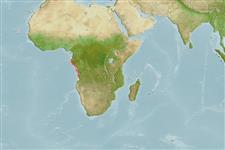Common names from other countries
>
Scombriformes (Mackerels) >
Trichiuridae (Cutlassfishes) > Lepidopodinae
Etymology: Lepidopus: Greek, lepis = scale + Greek, pous = foot (Ref. 45335).
Environment: milieu / climate zone / depth range / distribution range
Ecologia
marinhas bentopelágico; intervalo de profundidade 20 - 500 m (Ref. 10818). Tropical; 2°N - 18°S, 4°E - 14°E (Ref. 6181)
Eastern Atlantic: equator to 14°30'S.
Tamanho / Peso / Idade
Maturity: Lm ? range ? - ? cm
Max length : 43.0 cm SL macho/indeterminado; (Ref. 6181)
Raios dorsais moles (total) : 83 - 89; Espinhos anais: 2; Raios anais moles: 48 - 53; Vértebras: 91 - 96. Upper head profile slightly convex, rising gently from snout to nape; posterior confluence of frontal ridges before rear margin of orbits. Orbits nearly touching upper profile, interorbital space strongly convex. Pelvic fins reduced to 1 scale-like spine and 1 - 2 tiny soft rays. Pyloric caeca 13. Color is silvery; edges of jaws and opercle blackish.
Juveniles epipelagic to mesopelagic from 20 to 220 m (Ref. 6181).
Life cycle and mating behavior
Maturities | Reprodução | Spawnings | Egg(s) | Fecundities | Larvas
Nakamura, I. and N.V. Parin, 1993. FAO Species Catalogue. Vol. 15. Snake mackerels and cutlassfishes of the world (families Gempylidae and Trichiuridae). An annotated and illustrated catalogue of the snake mackerels, snoeks, escolars, gemfishes, sackfishes, domine, oilfish, cutlassfishes,. scabbardfishes, hairtails, and frostfishes known to date. FAO Fish. Synop. 125(15):136 p. (Ref. 6181)
Categoria na Lista Vermelha da IUCN (Ref. 130435)
CITES (Ref. 128078)
Not Evaluated
Ameaça para o homem
Harmless
Utilização humana
Ferramentas
Relatórios especiais
Descarregue XML
Fontes da internet
Estimates based on models
Preferred temperature (Ref.
115969): 13.2 - 17.3, mean 15.4 (based on 19 cells).
Phylogenetic diversity index (Ref.
82804): PD
50 = 0.5156 [Uniqueness, from 0.5 = low to 2.0 = high].
Bayesian length-weight: a=0.00275 (0.00105 - 0.00724), b=3.06 (2.83 - 3.29), in cm Total Length, based on LWR estimates for this (Sub)family-body shape (Ref.
93245).
Nível Trófico (Ref.
69278): 3.7 ±0.4 se; based on size and trophs of closest relatives
Resiliência (Ref.
120179): Elevada, tempo mínimo de duplicação da população menor que 15 meses (Preliminary K or Fecundity.).
Fishing Vulnerability (Ref.
59153): Moderate vulnerability (41 of 100).
